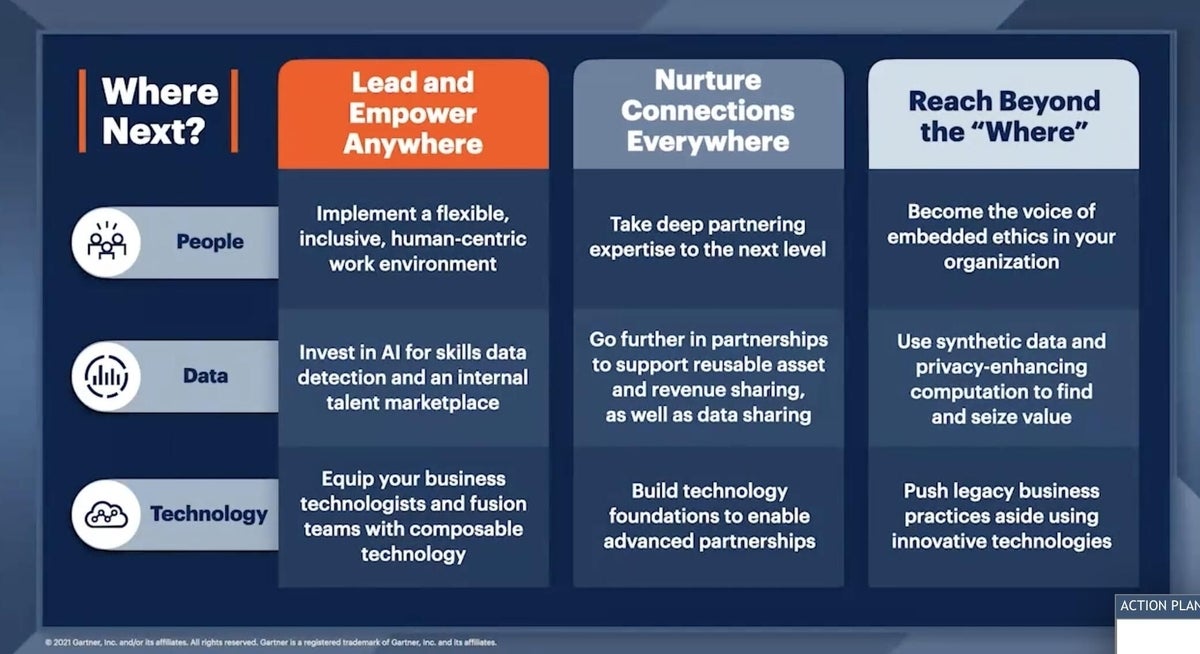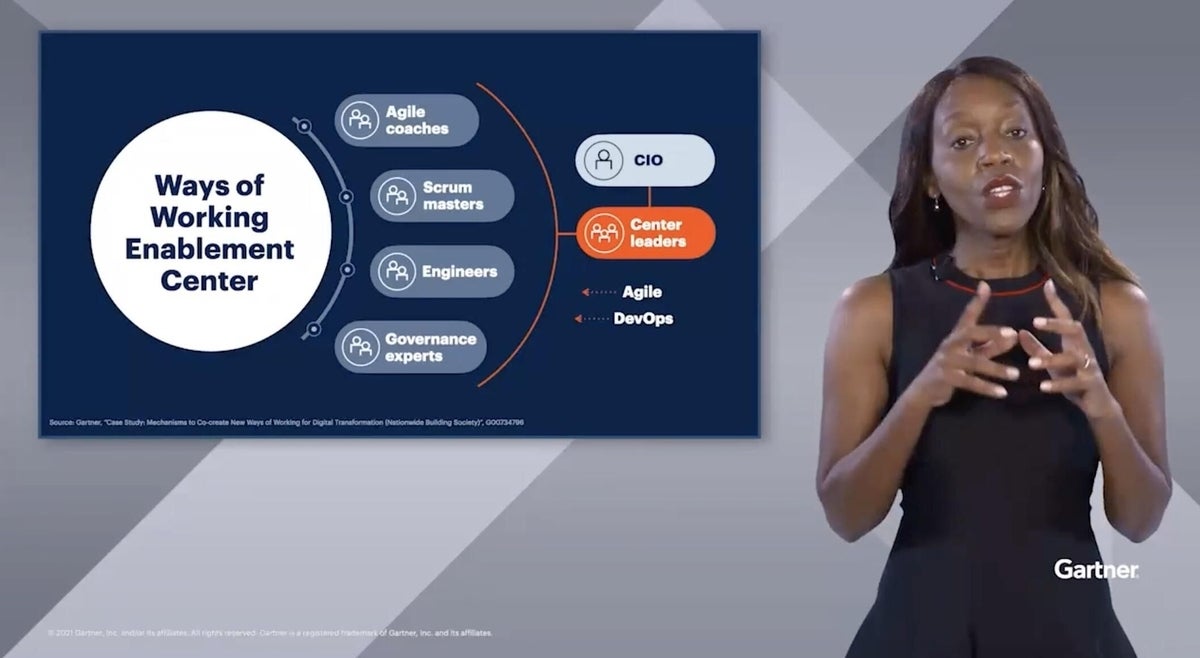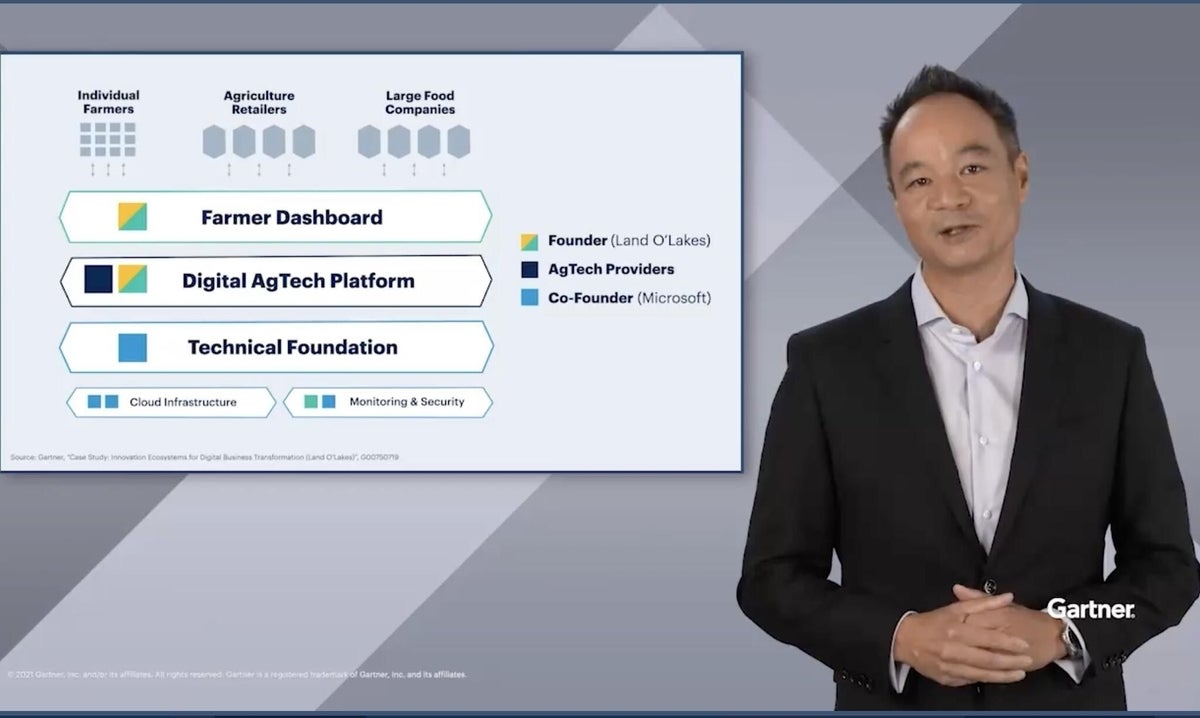
Image: Gartner
The sky’s the limit for CIOs as long as tech leaders are willing to let go of the “way we’ve always done it,” according to Gartner analysts. Three senior researchers in Munich, Toronto and Atlanta opened the Gartner IT Symposium/Xpo Monday. The event is all virtual this year and runs through Thursday.
“Where Next: Technology Leadership in a World Disrupted” opened the event with presentations from Mbula Schoen, senior research director on the CIO Leadership, Culture and People research team, Hung LeHong, distinguished research vice president and Daryl Plummer, distinguished analyst and Gartner fellow.
The trio described this moment in the tech industry as an opportunity that creates both anxiety and excitement at the same time. Schoen said that the world is obsessed with the idea of where: where will people work, learn, eat and play? CIOs will have to get creative in all areas of business to meet this challenge.
LeHong explained the three types of partnerships that CIOs need to build and Plummer explained how CIOs should seek out technology that has built-in support for minimizing bias, systematically confronting real harms and identifying ways to reduce them.

Image: Gartner
Fighting the Great Resignation
To explain how leaders need to shift their thinking about the where and when of work, Schoen used the ongoing return to the office debate. She said Gartner research showed that 14% of staff members want to be back in the office full time and 19% want to be remote full-time. Both groups are in the minority, compared to the larger group that wants “radical flexibility at scale,” she said, and the ability to work at the best place at any given time.
“Moving from on site to remote is not the end of the conversation, it’s a starting place for how we can lead going forward,” she said.
Gartner recommends taking this approach to rethinking the where, when and how of work:
- Build a human-centric workforce that takes into consideration more than the 9-5
- Embrace business technologists previously known as shadow IT
- Build an internal talent marketplace to benefit managers and workers
Schoen said that Gartner research has found that companies using this approach see these benefits:
- Reduce worker fatigue by 44%
- Increase the intent to stay up by 45%
- Increase performance up by 28%
Companies that embrace business technologists — defined by Gartner as people outside the IT department leading technology projects — will see faster delivery of services and products. Gartner research suggests that businesses that support these teams are 2.6 times more likely to accelerate business outcomes. Model Ops and Machine Learning Ops teams are two examples of this approach.
Schoen also said that 40% of corporate boards have moved funds to departments to support these business technologists, further accelerating this trend.

Image: Gartner
The importance of technology partnerships
LeHong explained how the pandemic has prepared the tech industry and society for change at a big scale.
“At no other time in history have we had this much opportunity to pursue technology-enabled change,” he said. “Tactical thinking is stopping us from doing this.”
LeHong used the example of hospital waiting rooms and managing crops as two examples of how partnerships can change the traditional approach to business.
Drones and AI have allowed farmers to limit the use of pesticides just as AI and telemedicine have allowed hospitals to revamp the waiting room.
LeHong said partnerships are the key to developing and deploying both of these solutions. He listed these three types of partnerships that CIOs need to use:
- 1:1 – Companies use these “generative partnerships” with a vendor to collaboratively build new solutions that don’t already exist.
- 1: Many – This approach focuses many players on a single problem, such as improving city services.
- Many: Many – This approach takes an ecosystem approach and builds a big team that includes consultants, subject matter experts and technologists to build a platform solution.
He used the example of how Land O Lakes uses this many to many approach to build a digital platform to improve feed operations for dairy farmers.
“The CTO estimated that it would have cost $2 billion to build all the solutions built by these developers,” he said. “Instead Land O Lakes spent less than $45 million to build the platform.”
He also mentioned Datev, a German IT company that specialized in accounting services.
“The CTO grew the company from 40 to 200 partners and from 700 clients to 45,000 in three years,” he said.

Letting go of past business practices
Plummer closed out the session with an explanation of the barriers that hold businesses back from embracing a new way of working and the idea of expanded partnerships. Where next cannot be just in terms of a location or direction. “It’s time for CIOs to seek out world-class problems and they are gaining both the nerve and the resources to make bold, world class moves,” he said.
He used the story of U.S. Deputy Marshal Bass Reeves to illustrate the challenge of letting go of outdated ideas. Reeves was born a slave but became a detective and the most prolific lawman ever, arresting 3,000 criminals. Reeves was the inspiration for the Lone Ranger, a character that has always been a white man in movies and books.
Plummer said companies need to find freedom from these three traditional business ideas:
- Historical insights
- Legacy practices
- Bias
For example, artificial intelligence, synthetic data and federated learning could remove the need to collect reams of data from consumers, Plummer said. This could protect privacy and still allow businesses to develop new products and services.
He used the example of Levi’s use of AI and ML to develop new services such as a virtual closet and to optimize shipping models.
“Levis changed legacy business practices to weather the pandemic,” he said.
Plummer described this point in the evolution of AI as a “reach beyond moment” that may require tech leaders to use machines to direct the ethical compass. He used the example of biased lending practices keeping millions of dollars out of the economy.
“AI can contribute to the problem and you’ll have to use AI to solve it,” he said. “Built-in bias requires a built-in response.”